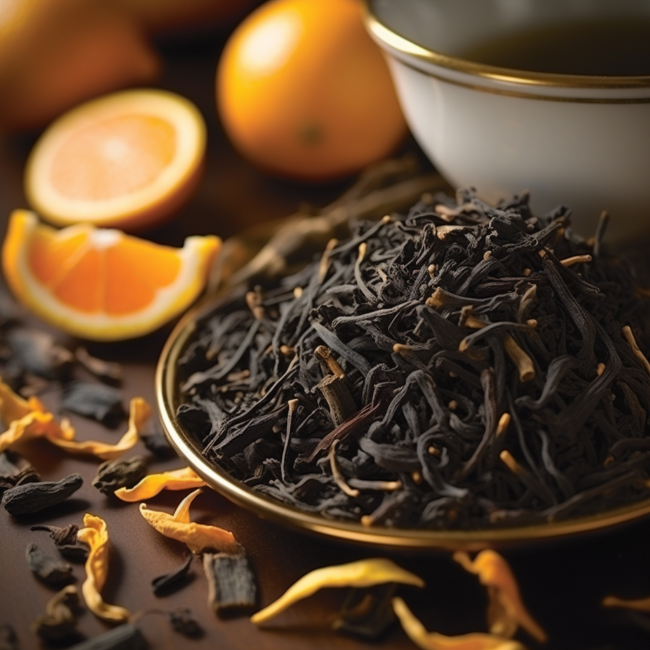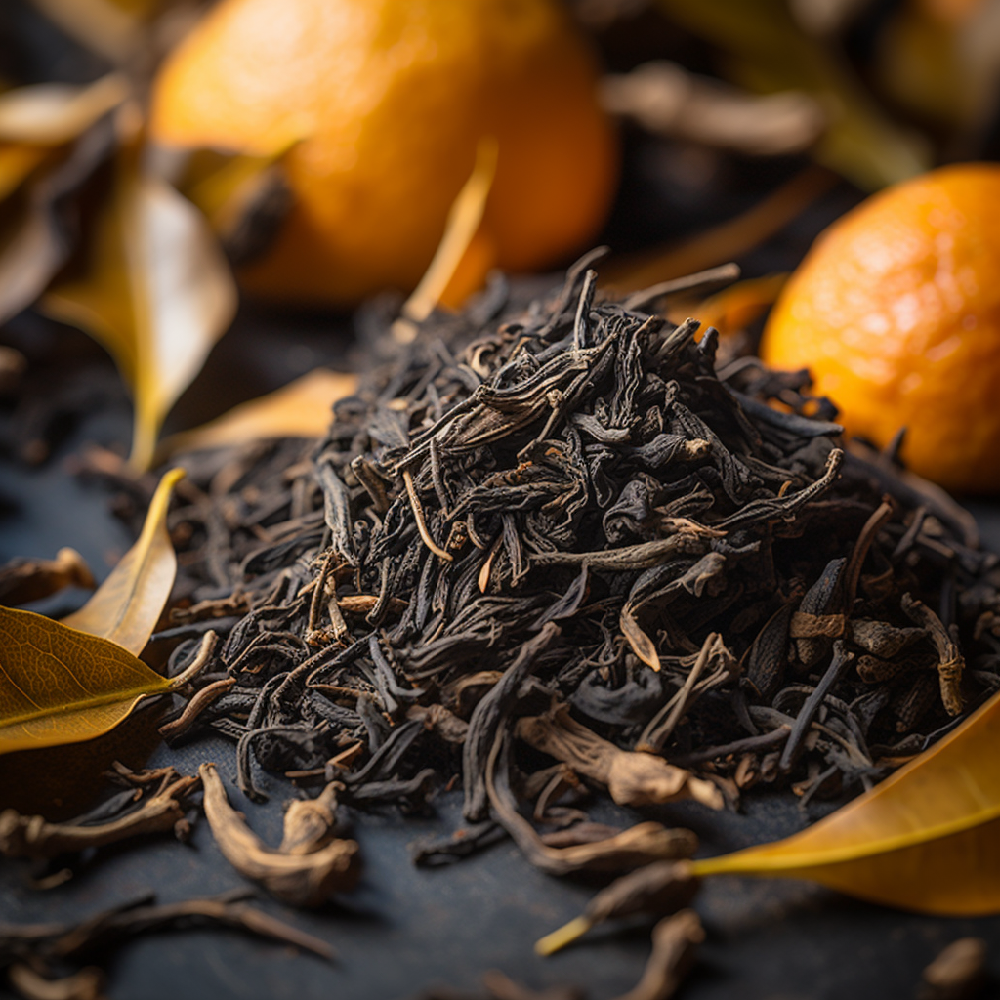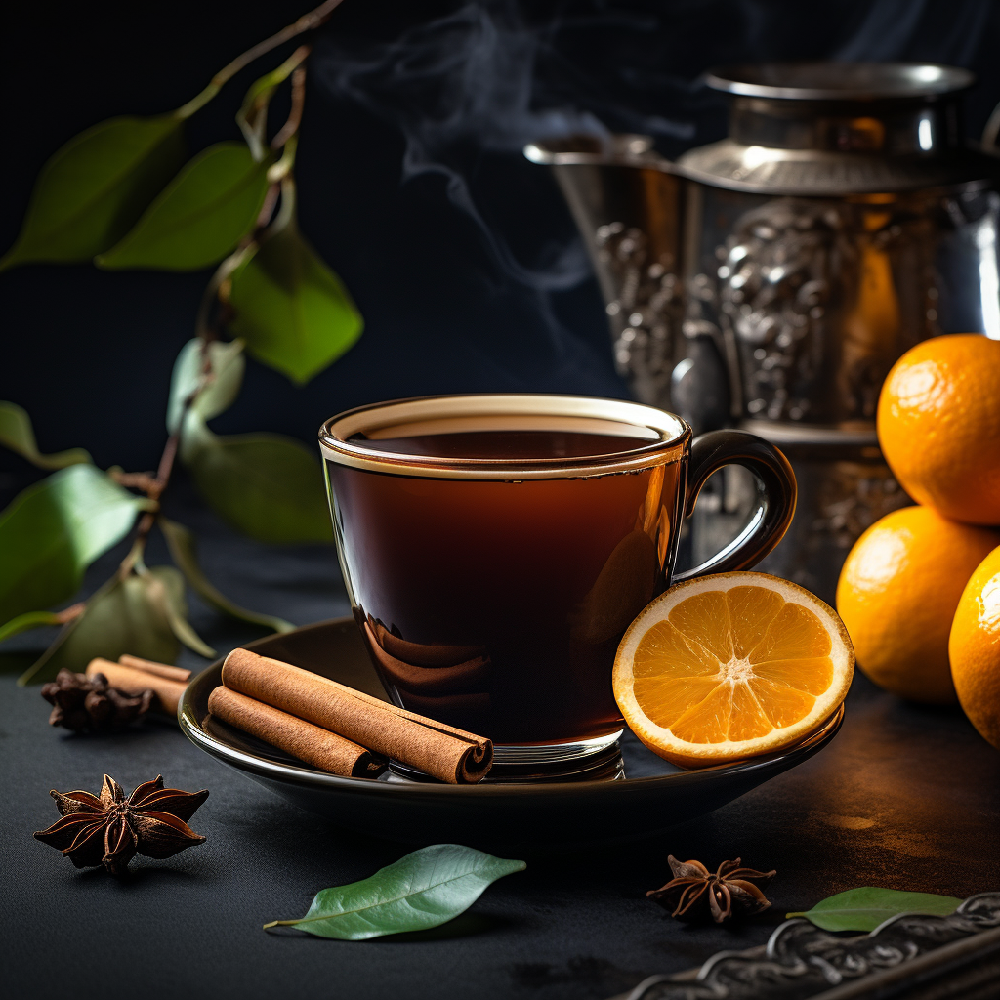
The Ultimate Guide to Earl Grey Tea
Do you also love that first sip of your steaming cup of Earl Grey in the morning? If so, you've come to the right place. In this article, we dive deep into the fascinating world of Earl Grey tea together. From its unique production to its rich history and health benefits, this guide will surprise even the most sophisticated tea drinker. So grab your favorite cup, pour yourself some Earl Grey, and join me on this tea-tastic journey.
What is Earl Grey Tea?

The world of tea is a never-ending adventure with endless varieties to discover. And one of those gems in this immense sea of flavors is, without a doubt, Earl Grey Tea.
But what makes this particular tea so special?
Earl Grey Tea is a fragrant, slightly bitter black tea that gets its refreshingly distinctive character from the oil of the Bergamot citrus fruit. The Bergamot gives Earl Grey its iconic citrusy twist, while the tea base - mostly red tea (black tea in the West) - contributes to its full body.
Now you may be wondering, who is the Earl Grey in the naming of this tea? The tea is named after Charles Grey, the second Earl Grey, and a former British Prime Minister in the 19th century. The fascinating story behind how this tea got its name is another reason to delve even further into the intriguing world of Earl Grey.
Since Earl Grey is such an iconic tea, it comes in many different variations. Although the original Earl Grey is made with a base of black tea, today you can find Earl Grey's made with green, white, and even oolong tea. Bergamot oil still provides a distinctive flavor, but the different types of tea bases offer a fascinating range of flavor nuances and notes. And that's just the tip of the iceberg when it comes to Earl Grey!
History of Earl Grey Tea
A conversation about tea would not be complete without a dip into its rich history. And the exciting story of Earl Grey Tea is one that definitely needs to be told.
As mentioned earlier, Earl Grey Tea is named after Charles Grey, the second Earl Grey, and a former British Prime Minister in the early 19th century. But how did this tea get its name?
Legend has it that a Chinese man, whose son was saved from drowning by one of Earl Grey's men, donated the recipe for this unique tea as a token of his gratitude. This special recipe, a black tea flavored with the oil of bergamot citrus, was so beloved by the Earl that he gave it his name and asked the Twinings brand to blend it for him.
Yet historical research shows that this romantic legend is probably not true. In Earl Grey's time, bergamot did not occur in China, and the Earl himself never went there. So it seems that story was more of a marketing strategy than a factual account.
The most plausible explanation for the origin of Earl Grey tea is that bergamot oil was added to tea in an attempt to mask the fact that the tea was damaged or of inferior quality. In a time without fast, refrigerated transportation methods, this was a clever way to still produce marketable tea.
Despite the mystery surrounding its true origins, there is no denying that Earl Grey has been a beloved choice for generations. With its refreshing taste and aroma, as well as its intriguing history, it's no wonder Earl Grey Tea still remains a favorite of tea lovers worldwide.
How is Earl Grey Tea made?

The production process of Earl Grey Tea is as fascinating as its history. It all begins with a careful selection of tea leaves and Bergamot oil.
The first step in making Earl Grey tea is picking the tea leaves. This is an extremely precise task, as the correct leaf type contributes to the final taste of the tea. The most traditional type for Earl Grey is black tea, although nowadays you can also find variations with green, oolong, and white teas.
After the tea leaves are picked, they are wilted, rolled and oxidized. This process creates the tea's dark color and deep flavor. Anyone who has ever noticed that western black tea in China is often called red tea, "red" here referring to the color of the infused liquid and not the color of the dry leaf, has a keen eye for detail. At Leaves with hugs, we decided to follow the Chinese naming theory.
During the oxidation process, the leaves are exposed to oxygen. This is the crucial moment when the leaves acquire their final flavor. Too long in this stage and the tea becomes bitter; too short and it may be too weak.
Once sufficiently oxidized, the tea leaves are dried to stop the oxidation process. Then, as the final step in the production process, Bergamot oil is added. This valuable oil, pressed from the peel of the Bergamot orange, gives Earl Grey its unmistakable, fresh citrus character.
At every step in this process, craftsmanship plays a key role, for it is the experience and skills of the tea producer that influence the subtle nuances of the tea. The result is a tea, which is complex yet refreshing, and loved by many - the incomparable Earl Grey.
The unique ingredients of Earl Grey Tea
What makes Earl Grey Tea so special is the combination of high-quality ingredients. Although the number of components in this tea is quite limited, the quality of each of these ingredients is strictly monitored.
The main ingredient of Earl Grey Tea is, of course, tea. However, the specific type of tea used can vary depending on the recipe. The classic version of Earl Grey Tea is usually prepared with black tea, but today there are also variants that use green tea, oolong tea, or white tea. It is important to note that not all tea that is not tisane is made from Camellia sinensis. There are several subtypes and cultivars. Camellia taliensis, for example, is one such exception.
The next key ingredient is the oil of the Bergamot fruit. The Bergamot is a citrus fruit and the oil from the rind of this fruit is what gives Earl Grey its distinctive, fresh-sour taste. This oil is often extracted using cold pressing, a method that ensures the purest and most fragrant oil. It goes without saying that the best Earl Grey Tea is made only with the very best Bergamot oil.
And there you have it - the building blocks of Earl Grey Tea are fairly simple, but the taste is anything but that. The subtle balance between the earthy, full flavor of the tea and the fresh, citrusy Bergamot makes every sip an adventure. It is the perfect blend of ingredients that makes Earl Grey such a favorite with tea lovers around the world.
Health Benefits of Earl Grey Tea
In addition to its delicious taste and captivating background, Earl Grey Tea also offers a range of potential health benefits. While not the same as medical treatment, the natural components of Earl Grey Tea can have a positive impact on your well-being. Here are some of the health benefits you may be able to get from your favorite cup of Earl Grey:
Digestive health: The Bergamot oil in Earl Grey Tea has long been known for its positive effects on the digestive system. It could help relieve digestive disorders and may contribute to an overall better feeling after meals.
Enhanced hydration: Although a caffeinated beverage, tea generally has a positive effect on hydration, provided one consumes it in moderation. And since hydration is essential for almost all bodily functions, every cup of Earl Grey Tea is a step in the right direction.
Mental health: There is research suggesting that the citrus scent of Bergamot oil can help reduce anxiety and improve mood. So a cup of Earl Grey Tea could provide a calm moment in a hectic day.
It is important to remember that more is not always better and that excessive caffeine consumption can have negative effects. Let me take a moment to point out that it is not the case that one type of tea (e.g., black) may or may not contain more or less caffeine than another type (e.g., green). The amount of caffeine in tea is variable depending on harvest time, weather conditions, processing, and other factors. This is something to keep in mind when enjoying your favorite tea.
All in all, the potential health benefits of Earl Grey Tea may be an additional reason to enjoy this iconic brew. But remember, the best reason to drink Earl Grey Tea is always its deliciously unique taste.
How do you make the perfect cup of Earl Grey Tea?

Nothing beats a perfectly brewed cup of Earl Grey Tea. It is the ultimate way to bring out both the subtle aromas of the tea and the fresh flavors of the Bergamot. But how do you brew the perfect cup of Earl Grey Tea? While taste is obviously subjective, there are a few golden rules to keep in mind.
The first thing you need is, of course, quality tea. No matter how good your water or your teapot is, you can't make a good cup of tea without good tea. Especially with a tea like Earl Grey, where the taste is so dependent on the quality of the tea and the Bergamot oil, this is very important.
Once you have chosen your tea, you need to choose the right water. Clear, pure water that is free of chemicals plays a big role in making a tasty cup of tea. The water should also be at the right temperature. For black tea, and therefore for most types of Earl Grey Tea, it is ideal to use water that is just off the boil.
To brew the perfect cup of Earl Grey, usually let the tea steep for 3 to 5 minutes. However, the exact time depends on your personal taste preference. Keep in mind that letting the tea steep too long can result in a bitter taste.
Many enjoy their Earl Grey pure; others like to add a slice of lemon or a cloud of milk. Lemon can enhance the citrusy character of the tea, while milk adds a bit of creaminess and smoothness.
At the end of the day, the most important thing in brewing the perfect cup of Earl Grey is to enjoy the process. Making tea is about more than just the end result. It's about the rituals, the smells, the anticipation of that first sip, and the peace of mind that brewing a delicious cup of tea can provide.
Different variations of Earl Grey Tea
If you think there is only one kind of Earl Grey Tea, you are wrong! Earl Grey Tea comes in as many variations as there are stars in the sky... Well, almost then. From traditional to modern, here's an overview of some of the most popular variations of Earl Grey Tea.
Classic Earl Grey: Made from black tea and bergamot oil, the Classic Earl Grey is the version most people know and love.
Lady Grey: A lighter, more fruity version of the classic Earl Grey, Lady Grey often contains additions of citrus peels and even blue cornflower petals for some extra color.
Green Earl Grey: For those looking for a slightly lighter tea with the same bergamot flavor, the Green Earl Grey is an excellent choice. Instead of black tea, this blend is based on green tea.
Rooibos Earl Grey: A decaffeinated option, rooibos is a South African plant that, when blended with bergamot oil, forms a delicious Earl Grey version.
White Earl Grey: This version is where luxury and sophistication come together. White tea leaves are the least processed of all tea types, and when combined with the citrusy freshness of bergamot, you get a delicate and refined cup of Earl Grey.
The wonderful thing about Earl Grey Tea is that there is a blend to suit almost every mood and time of day. Whether you want to start your morning with a robust Classic Earl Grey or end your evening with a soothing Rooibos Earl Grey, the possibilities are endless.
The difference between Earl Grey and other teas
With its distinctive citrus aroma and tangy flavor profile, Earl Grey Tea is in a class of its own. But how does it hold up against other teas?
The main difference between Earl Grey and other teas is, of course, the use of Bergamot oil. This oil, extracted from the peel of the Bergamot citrus fruit, is the characteristic flavoring agent of Earl Grey Tea. No other tea boasts this unique blend of citrus and tea.
Looking at the type of tea leaves used in Earl Grey, you won't see a big difference from other teas. Most Earl Grey's are made with a base of black tea, but there are also variations with green, white or oolong tea. This is similar to other teas in the wide range of tea blends.
When it comes to tea flavor, each variety has its unique nuances and characteristics. Compared to other black teas, such as Darjeeling or Assam, for example, Earl Grey is generally a bit lighter and more fragrant, thanks to the addition of Bergamot oil.
In terms of the health benefits of tea, most teas are fairly similar, as they all come from the Camellia sinensis plant, or in the case of Rooibos Earl Grey, the Rooibos plant. However, each tea has its specific properties and benefits, so it may be worth trying different varieties and seeing which one you like best.
Essentially, Earl Grey Tea is a unique blend that deserves to be recognized for its own wonderful flavor profile. It is not necessarily better or worse than other teas - it is simply different. And that is something every tea lover can appreciate.
The right time to drink Earl Grey Tea
Is there a "right" time to lose yourself in a cup of your favorite Earl Grey Tea? The simple answer, of course, is: the best time to drink Earl Grey Tea is when you feel like it! However, depending on the type of tea you use, your particular taste preference, and even your metabolism, there are certain times of day when drinking Earl Grey Tea can be particularly beneficial or enjoyable.
The most traditional time to drink Earl Grey Tea is at breakfast. The smooth, uplifting flavor of the Bergamot oil is a great way to start your day. Combined with the caffeine content of the black tea, a cup of Earl Grey can certainly give you an energy boost to start your day off right.
Another popular time to drink Earl Grey is in the afternoon, as an afternoon snack or to overcome a dip in energy levels. A nice cup of Earl Grey can indeed do wonders to boost your mood and energy!
In the evening, a cup of Earl Grey can also be enjoyable, especially if you choose a decaffeinated variety such as Rooibos Earl Grey. The relaxing ritual of making tea and the gentle aroma of the Bergamot can contribute to a calm and relaxing evening.
So there are really no strict rules when it comes to determining the "best" time to drink Earl Grey Tea. It all comes down to your personality, lifestyle, and preferences. So whether you enjoy an early morning cup, an afternoon pick-me-up, or a quiet evening treat, there is always a perfect time for a delicious cup of Earl Grey.
How do you store Earl Grey Tea for the best quality?
Good tea deserves good care. So if you're a fan of Earl Grey Tea, you want to make sure you store it the right way to preserve its delicious flavor and aroma. Here are some simple tips for keeping your Earl Grey Tea fresh.
Sealed: Air can affect the flavor and aroma of Earl Grey Tea, so it is important to store your tea airtight. You can do this in a tea tin or in an airtight bag. Be sure to seal it tightly after each use.
Dry: Moisture is another enemy of tea. It can cause mold and spoilage and greatly affect the taste. So store your Earl Grey Tea in a dry place, preferably away from the kitchen counter or sink.
Dark: Light, especially direct sunlight, can affect the taste and color of tea leaves. It's best to keep your tea in a dark place, such as a cabinet or drawer.
Away from strong smells: Tea can absorb other smells, and you don't want that when it comes to your Earl Grey. So store your tea away from spices, coffee, or other strong odors.
No freezing: While it may be tempting to store your tea in the freezer for longer freshness, this can also cause moisture problems, especially when the tea is removed from the freezer and condensation forms on the leaves. It is better to store your tea at room temperature.
Properly preserved tea provides a better infusion and a more satisfying tea experience. So take the time to store your Earl Grey Tea properly, and you'll get the best taste every time you brew a cup.
Pairing Earl Grey Tea with food
If you think food and drink only go with wine and dishes, it's time to expand your horizons! Earl Grey Tea has a unique flavor that goes with many different foods, and it can really take the dining experience to the next level. Here are a few suggestions.
Sweet afternoon treats: Earl Grey Tea is a classic choice of afternoon tea in England, and for good reason! The citrusy notes of the Bergamot go wonderfully with sweet treats like cakes, cookies, scones, and jam. Try it with a slice of lemon cake or a piece of dark chocolate.
Savory dishes: The robust flavor of Earl Grey Tea can also be a fantastic complement to savory dishes. Sandwiches with chicken, fish, or cheese can go especially well with this tea. The slight citrusy undertone can give a fine balance to these savory dishes.
Desserts: In the last few years, chefs and home bakers have begun experimenting with Earl Grey Tea as an ingredient in desserts. Think Earl Grey ice cream, cakes topped with Earl Grey syrup, or even Earl Grey macaroons. There is no denying that the light, floral flavor of Earl Grey Tea can work wonders in sweet, creamy treats.
Cheeses: Yes, you can combine tea and cheese! The strong flavor of blue cheese, for example, can be softened by the fresh citrus flavor of Earl Grey. Or try it with a creamy brie or a sharp cheddar. The contrast of the strong cheese flavor with the more subtle Earl Grey can be an interesting and flavorful experience.
Whether you drink Earl Grey Tea with your breakfast, lunch, afternoon snack, or dinner, there are virtually no rules! The important thing is that you enjoy both the food and the tea to the fullest.
Hugs,
Admar
.png)

